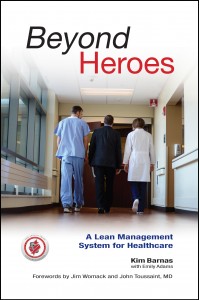Performance Process: Accountability
Post 3 of 4 in a Blog Series by Kim Barnas
As I visit healthcare organizations around North America, people come forward sharing concerns that they are hitting a wall, even within the management system. Often what I hear is that they have implemented stat sheets and huddles, but not all of them have implemented a performance review process. The management system is just that—a system! The goal is to develop people to solve problems and improve performance. How do you know if your problem solving is driving improvement if you are not measuring it?
Each area should have a scorecard and visual management reporting on the daily, weekly, and monthly performance for the True North drivers. Remember each driver has an A3, so in the monthly review, the effect of the last 30 days and the next 30 days will become the focus. Are we consistent? Have we developed standards? Are we improving? What experiment are we going to do in the next 30 days?
The metrics reviewed should be specific to the unit and roll up to the division such as the hospital division, primary care division, etc., and finally they all should roll up and impact the True North metrics. The effect on the True North measures should be reported at the senior executive level as well as to the board of directors.

Performance Review Meeting in Progress
The performance review process is meant to connect the work at the unit and divisional level, with True North and the work in the system (strategic drivers). It is an opportunity to communicate business performance and needs, barrier removal, and allow for forced reflection. It is an avenue for using and demonstrating the A3 problem solving process around performance drivers—observing the PDSA cycle. This is where accountability is most visible.
Consequently, if you are
- Proactively planning your day, you will begin to see waste and defects (status exchange).
- Developing your people to be critical thinkers, then they can anticipate problems and develop countermeasures.
- Developing problem solving skills where the countermeasures tie to True North targets, you should see improved performance!
These 30 day rapid cycles of improvement create accountability by using lean methodologies to get to root-cause and develop experiments/countermeasures to improve performance. The 30 day cycle will cause forced reflection through PDSA cycles and require that we study and adjust! We can move beyond Plan and Do. At these meetings, we will review the action plans (Plan) and expect to understand the following:
- What did you do to improve performance last month (What were your experiments/countermeasures)? (Do)
- Did they affect your performance? (Study)
- Are you getting more consistent? (Study)
- Are you improving? (Study)
- If not, what are you going to do differently in the next 30 days? (Adjust)
The accountability and awareness becomes heightened, others in the meeting can influence the work, and everybody knows what each other is working on to drive performance. The monthly performance review is the piece that seems to be missing in a lot of organizations.
 So if you are going to talk about measuring your return on investment, and I do not just mean financial return on investment, but also your quality return on investment and your service return on investment, you better be measuring it. At some point we must be able to talk to the community, board members, and staff about how important the work is that we are doing—taking care of sick people every day and finding better ways to make them better. Wouldn’t it be great if we could describe how and why we are better at it? Through performance reviews you can report with confidence back to your community that you are good stewards of their resources. A performance review process is a must.
So if you are going to talk about measuring your return on investment, and I do not just mean financial return on investment, but also your quality return on investment and your service return on investment, you better be measuring it. At some point we must be able to talk to the community, board members, and staff about how important the work is that we are doing—taking care of sick people every day and finding better ways to make them better. Wouldn’t it be great if we could describe how and why we are better at it? Through performance reviews you can report with confidence back to your community that you are good stewards of their resources. A performance review process is a must.
For more information on the performance review process, check out Beyond Heroes. If you want to learn more about setting up an improvement system and how to track improvement with scorecards and other elements, we have a number of books and DVDs available in the Center’s online store that can help get you started.








Leave a Reply